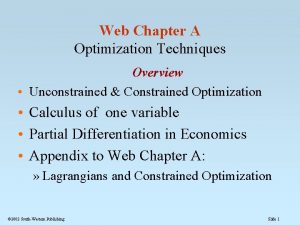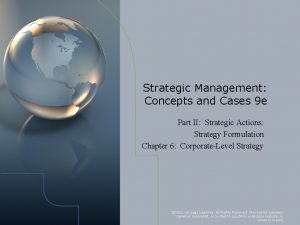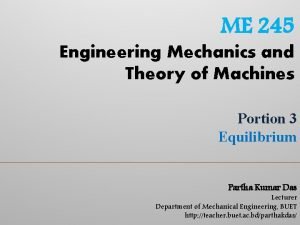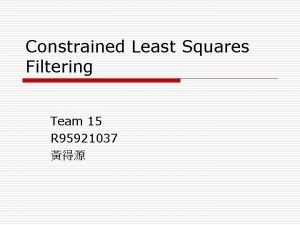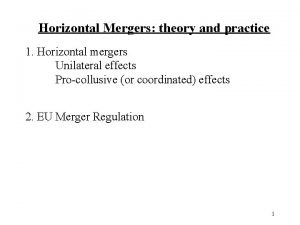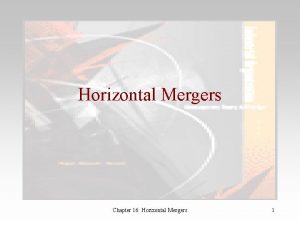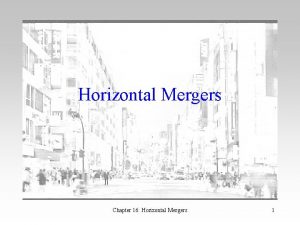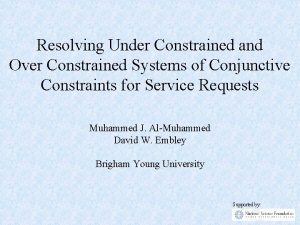1 HORIZONTAL MERGERS WITH ONE CAPACITY CONSTRAINED FIRM











- Slides: 11

1 HORIZONTAL MERGERS WITH ONE CAPACITY CONSTRAINED FIRM INCREASE PRICES David J. Balan (FTC) Patrick De. Graba (FTC) Jason O’Connor (FTC) April 21, 2018 The views expressed in this paper are those of the authors and do not necessarily reflect those of the Federal Trade Commission.

UPP and Merger Effects • Why do mergers of substitutes raise prices? • Often explained in terms of Upward Pricing Pressure • e. g. , 2010 DOJ/FTC Horizontal Merger Guidelines • UPP > 0 if and only if D 12(P 2 –C 2) > EC 1 • This is fundamentally about recapture of lost sales • Start with the pre-merger price • Benefit to Firm 1 ↑ its price by a small amount equal to the loss • After the merger, benefit is the same, loss is smaller • This is because a fraction D 12 of the lost sales go to Firm 2 • Those sales, and the profit (P 2 –C 2) are “recaptured” • If this effect exceeds the efficiencies EC 1, then P 1 ↑

UPP and Merger Effects • This is a valuable way to think about mergers • It is intuitive and it is useful as a pedagogical device • It may also be useful for quantitative merger simulation • Weyl & Jaffe (2013), Miller et al. (2016, 2017) • But recapture is not the only source of merger effects • And applying the recapture intuition in the context of capacity constraints is positively misleading

UPP with a Capacity Constraint • Pre-merger, Firm 1 faces binding capacity constraint K • Let Firm 1 and Firm 2 merge • For a given P 2, Firm 1 will not want to change its price • Price ↓ is unprofitable (lower price for same sales of K units) • Price ↑ is ruled out by the assumption that the constraint binds • Firm 2 should want to raise its price as long as D 12 > 0 • This is the logic of UPP • But Firm 1 cannot accommodate any diverted sales • So it might appear that Firm 2 will not ↑ its price • That is, the logic of UPP appears to suggest no merger effect with even one constrained firm

UPP with a Capacity Constraint • This has been claimed explicitly in defense of mergers • Q. So that was a lot about Hershey. What about Pinnacle? • A. Pinnacle is in a different situation because while there is some demand side substitutability as there is between Hershey and Pinnacle, but between Pinnacle and Hershey, as well, there's some overlap, it's just in the context of one being community and the other being academic, it is not all that substantial, but there's some, to be sure, without taking the capacity constraint into account. • But once capacity is taken into account, there can't be substantial diversion of patients from anywhere, but, in particular, from Pinnacle to Hershey, say as a result of some imagined price increase or some competitive event that is being assessed, because Hershey just doesn't have the capacity to take on a major influx of patients from Pinnacle as a possible result of whatever, a natural disaster, we hope not, or a price rise. No, it just -- it won't happen. • So that the practical diversion between Pinnacle and Hershey is insignificant due to Hershey's capacity constraint, as well as due to the differentiation of their services. But that means that the diversion ratio, in practical terms, because of the capacity constraint, is de minimis. And the conclusion is at the bottom of the slide. That means that upward pricing pressure in that direction, the upward pricing pressure from the merger on Pinnacle is negligible. • (Expert testimony of Professor Robert Willig in Federal Trade Commission and Commonwealth of Pennsylvania vs. Penn State Hershey Medical Center and Pinnacle Health System, April 15, 2016. ) • Other examples exist as well

Non-UPP Merger Effects • UPP is about internalizing recaptured sales • With the constraint, there are no net recaptured sales • But after the merger, Firm 2 DOES internalize the fact that an increase in P 2 increases the price at which Firm 1 sells out its constraint K • This is sufficient for an increase in both prices • This is a simple point, but commonly misunderstood

Model Using Bertrand • The natural way to model this would be Bertrand • But there is a well-known problem with Bertrand • Pure strategy equilibrium may not exist when MC ↑ • Certain not to exist when MC is vertical at the constraint • Could try to model a mixed-strategy equilibrium • See Chen & Li (2018) • But that is not what we do

Model Using Cournot • In standard Cournot, mergers are not always profitable • But when they are profitable, they ↑ prices • Salant et al. (1983), Perry & Porter (1985) • The intuition is that the each of the merged firms internalizes the effect of a reduction in its output on its merger partner, via the resulting price increase • Having one merging firm be capacity constrained does not change this basic intuition • The idea that merger effects come from recapture of lost sales following a price increase does not apply to Cournot, so the confusion discussed above does not arise

Model Using Stackelberg • The claim that mergers have no effect in the presence of a capacity constraint is usually made in the context of price-setting games • As discussed above, there are problems with Bertrand • So instead we use Stackelberg • Firm 2 (and other rivals) choose prices in Stage 1 • Firm 1 (constrained firm) chooses its price in Stage 2 • (Results for the opposite case, where Firm 1 chooses its price in Stage 1 and Firm 2 and rivals choose in Stage 2, are in process but we believe the answer to be the same)

Model Using Stackelberg Pre-merger, Firm 1 chooses price to sell exactly K Given this, effect for Firm 2 of small change in P 2 is 0 But higher P 2 ↑ the price at which Firm 1 sells K So the effect of a small change in P 2 is positive for P 1 Pre-merger Firm 2 does not care about this But after the merger this effect is internalized So following the merger both prices will ↑ Even though there was no recapture of lost sales At the post-merger equilibrium, Firm 1 may produce at the constraint K or may produce less (i. e. , may cease to be constrained) • But either way both prices ↑ • • •

Conclusion • The logic of UPP is useful • But it is not a complete account of where merger effects come from • Usually this is not a serious problem, but it becomes one when UPP is used to analyze a merger with one capacity constrained firm • The logic of UPP appears to indicate that such mergers have no effect • This is simply incorrect: merged firms internalize price effects even when there are no net recaptured sales
 Andrea goldsmith wireless communications
Andrea goldsmith wireless communications Constrained nodes and constrained networks
Constrained nodes and constrained networks Constrained nodes and constrained networks
Constrained nodes and constrained networks Constrained and unconstrained optimization in economics
Constrained and unconstrained optimization in economics What is related constrained diversification
What is related constrained diversification Corporate relatedness vs operational relatedness
Corporate relatedness vs operational relatedness Improperly constrained
Improperly constrained Improperly constrained
Improperly constrained Constrained random verification
Constrained random verification Tower crane free body diagram
Tower crane free body diagram Statically determinate and indeterminate structures
Statically determinate and indeterminate structures Constrained least square filtering
Constrained least square filtering



